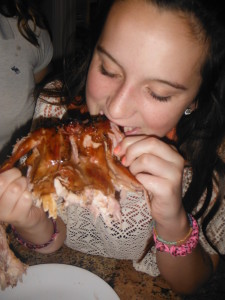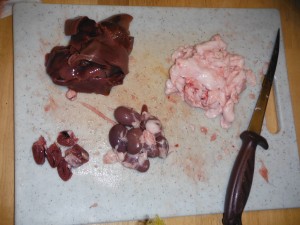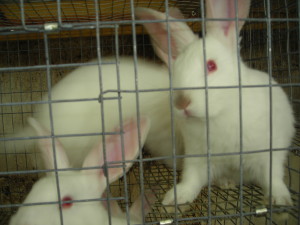I receive a lot of emails every day regarding the stuff I write about. While I like to help out, I don’t consider myself an expert, just someone that, Like Edison, has already learned a few ways things DON’T work.
So in spreading my personal knowledge, I thought I’d compile some of the questions I’ve received over the last couple years, and supply my answers as well. Q – You EAT RABBIT?

A – Yes. It tastes good and is easy to raise. It is a healthy animal protein, and when I raise it myself, I know what it is eating, and what it is NOT eating. This means I know what my family is eating. Can you tell me what the chicken that made up your chicken nuggets was eating?
Q – How hard are they to raise?
A – As easy as you want them to be. The requirements are simple – a secure location, food, water, shelter from the elements. I spend as little as 5 minutes a day with them, but like to go out and interact with them for an hour or two as often as I am able. I feel this makes handling them much easier.
Q – We have a few meat rabbits in part due to your comments/posts. We have our first “batch” of babies and I was wandering if you would share your sausage making process with us.
– and –
One more question about the rabbit sausage. Do you always add some sort and some amount of meat to the kidneys, heart, and liver?
A – I make rabbit sausage as a byproduct of cutting up my rabbits, as a way to  utilize as much of the animal as I can. I include all fat from the rabbits, as well as the hearts, kidney’s and liver (being sure to remove the gall bladder). I also throw in any scraps from quartering, usually the meat off the belly and ribs, since I don’t do much with them. Also any other tidbit that is left over from trimming up, such as the tips from the backstraps.
utilize as much of the animal as I can. I include all fat from the rabbits, as well as the hearts, kidney’s and liver (being sure to remove the gall bladder). I also throw in any scraps from quartering, usually the meat off the belly and ribs, since I don’t do much with them. Also any other tidbit that is left over from trimming up, such as the tips from the backstraps.
All is ground together, usually twice, and I then add in spices. I rarely measure my spices, I just throw in things that work for my tastes. Normally I’ll add in rosemary, garlic powder, onion powder, and sometimes sage.
The trick, I’ve found, is to test-fry a small bit as I’m adding in spices, then tasting it. I then add in whatever I think it needs, remembering you cannot take out anything, so whatever is added should be done in small increments, cooking a bit and tasting as you go.
Since I do not add in any cure, this is a “fresh” sausage, and should be eaten within a few days, or frozen.
Q – Where do I buy meat rabbits to get started?
A – First, ANY rabbit is made of meat, take what you can get, if the pickings are slim. But you should try to find a decent breed, such as New Zealands for meat production. I’ve eaten a lot of other breeds, and they all taste about the same…
As to a source, start with Craigslist. You can also try your local feed store, and if you have one, the 4H club.
Q – I noticed your pic of New Zealand White, Do you have your rabbits inside/air conditioned or outside? I live in FL to and I am just getting started raising rabbits. I am concerned about the heat here and I would be interested in knowing how you deal with it.
A – One thing I stress is if you are in a hot climate, look for breeding stock closer to the equator than you are, and if you are in a colder climate, look for breeding stock closer to the pole in your hemisphere. For example, I live in southern Florida, temps get into the 90s regularly. I purchased breeding stock from a breeder an hour south of me. His rabbits were used to the heat, so by moving them north (slightly cooler), they had an easier time dealing with the heat.
 My rabbits are housed outside in suspended cages, with plenty of ventilation. They are located on the north side of a block building under a large mango tree. The tree provides LOTS of shade, the block building also remains cool, and there is an almost constant cross breeze flowing east to west. Whenever they summer heat gets to be too much, I have a truck radiator fan hooked to a thermostat that automatically kicks on. (It’s powered by the batteries charged by my solar panels.)
My rabbits are housed outside in suspended cages, with plenty of ventilation. They are located on the north side of a block building under a large mango tree. The tree provides LOTS of shade, the block building also remains cool, and there is an almost constant cross breeze flowing east to west. Whenever they summer heat gets to be too much, I have a truck radiator fan hooked to a thermostat that automatically kicks on. (It’s powered by the batteries charged by my solar panels.)
Q – What type of housing do you use?
-and-
Where do you get your cages? So the hang? If so how?
A -I only use all wire cages, with 1 inch by 1/2 inch galvanized before weld 14 gauge floors. I prefer Baby Saver wire, and suspended next boxes in all my cages (thanks to the suggestion from Aaron at InTheRabbitHole.com).
I have build my own cages, but in order to save money doing this, you need to buy wire by the 100 foot roll, not a cheap proposition. And since I don’t need 15 cages, I’ve decided to simply buy pre-made kits from either:
http://www.klubertanz.com or http://www.bassequipment.com
Both offer well made designs at reasonable prices.
My preferred cage currently is 24x36x18, with baby saver wire. They are hung from hooks on the back side of a frame, and wire form the front. Chains would also work.
Q – Is six cages the minimum to breed for a food supply ?
A – Two cages would be a minimum, but three is a better starting point. Most 4H rabbit raisers use a “meat trio”, or a buck and two does as a competition point, and it works well with getting started. I like to have two does kindle (give birth) at the same time, so if there are any complications, or over/under-sized litters, I can adjust things. It is then a simple matter of adding another cage and doe whenever you want to expand. After you have a buck and 4 or 5 does, you should think about adding in a second buck from different bloodlines. This will expand your genetics out to an easy to sustain level (less crossbreeding).
On the subject of breeding, line breeding is a common method of developing stronger traits. The problem is that by line breeding, you can also strengthen bad traits. So starting with good stock is important for the long term, but can be developed as you progress. So for most startup rabbit breeders, three is enough.
That should be plenty for you to mull over in regards to raising rabbits. They are affectionate, intelligent, and tasty. They are virtually silent, their manure is “cool” and can be applied directly to plants and plant beds without burning, and rabbits are tasty. They require very little space, very little time, and yes, they are tasty.
Drop me a line is you have any questions. I am happy to share my understanding and experiences of raising rabbits. And if you want some excellent Rabbit how-to reading, check out Storey’s Guide to Raising Rabbits, one of the best sources of information I’ve found in regards to meat rabbits.
Peace,
db
As always, please “like” FloridaHillbilly on Facebook, subscribe to my feed, follow me on Twitter, add it to Google+, Pinterest, Linkdn, Digg, and/or tell your friends! The more folks that start behaving like ants, the fewer grasshoppers there will be left needing help.
Need something from Amazon (and who doesn’t)? I earn a small commission from purchases made when you begin your Amazon shopping experience here. You still get great Amazon service and your price is the same, no matter what.
I guess at some point I need to break down and just buy a few since now I have the cages.
I did have this friend that told me if I bought the cages he would supply the rabbits. I guess he was blowing smoke up my ass though…LMAO…:-p
I’m fairly certain the free rabbits did NOT include delivery
Sorry didnt read the fine print…:-D